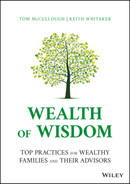SECTION 1
THINKING THROUGH WHAT MATTERS MOST
We begin this book of tools and exercises at the beginning: with what truly matters to you. Of course, the aim of these chapters is not to tell you what matters or what should matter to you, but rather to help you and your family members discern and clarify what matters to yourselves.
The first Wealth of Wisdom volume (The Top 50 Questions Wealthy Families Ask) offered its readers questions to explore. This volume focuses on exercises or tools, but sometimes questions can be tools too. In the first chapter in this section, Ellen Perry offers four questions to discuss as a family:
- What can I do more of that makes you feel close to me?
- What can I do less of that makes you lean out emotionally?
- What do you wish I understood more about who you are or what you value?
- What are your favorite stories from childhood and why?
Sometimes the simplest questions are the hardest to answer and the most rewarding to discuss.
Many people express what matters most in the form of “values.” As a result, many families seek to clarify their shared values, as a guide to action. In the next chapter in this section, Doug Baumoel and Blair Trippe help readers discern their “actionable values,” that is, values that, in one's experience, have led to specific outcomes or results. By focusing on actionable values rather than individuals' beliefs (political, moral, or otherwise), families can mitigate conflict and identify powerful shared direction.
Sharna Goldseker and Danielle Oristian York also take up the subject of values, by offering readers a simple but powerful tool in the form of lists of values-words on cards that readers can sort for themselves and then use as a group to distinguish individual and shared values. This simple process can offer insights to families in fields such as philanthropy and enterprise governance and, most importantly, in simply understanding and appreciating each other.
In the next chapter, Richard Franklin and Claudia Tordini broaden the lens on what matters by taking up the subject of well-being. (The root of the word “wealth” itself points to “well-being.”) Franklin and Tordini offer readers ways to assess their own sense of well-being and to talk, as a family, about what well-being means to them, using different domains of physical, social, career, community, and financial well-being. Through these discussions, families can more clearly decide how to allocate their financial wealth to foster their true well-being.
Kofi Hope and Zahra Ebrahim focus readers on the topic of identity, which for many is an important element of their personal “wealth.” Using a wheel listing various forms of identity, and a process of first clarifying how you see yourself and then how the world sees you, they set up the basis for a family conversation about what identities members bring to shared work such as philanthropy or business.
Human beings have long recognized that character is absolutely essential to our happiness; as the distillation of our choices and habits, it becomes our destiny. Kristin Keffeler uses contemporary psychological tools to help readers identify their own signature character strengths, which then allows family members to see how their strengths may complement or conflict with one another, and to concentrate their efforts on developing desired strengths.
Another element of what matters most is a sense of purpose and meaning in life. In this chapter, Don Opatrny and Keith Michaelson share the Japanese concept of “Ikigai” (“a reason for being”) as a tool to allow readers to clarify the intersection of what they love, what the world needs, what they can be paid for, and what they are good at.
Financial wealth is no doubt something that matters—but, beyond paying for basic necessities, why does it matter? That's a question that each of us would likely answer in different ways, and the answers matter to our sense of who we are and how we should use our wealth. To explore one's relationship with money, Courtney Pullen offers a framework of stages in wealth integration. It is meant to be used by families in a half-day setting, in which family members can explore both the positive and negative aspects of their beliefs about financial wealth.
Another way to approach our relationship to money is through reflecting on the stories that we tell ourselves about it, stories that are often rooted in long-ago events or even in stories that we heard from our parents or grandparents. In the next chapter, Jill Shipley gives readers a process for identifying the beliefs they hold about money, locating the root of those beliefs in stories they tell themselves about financial wealth. She then shows how readers might reconsider their desired relationship to money and come up with new stories that foster that desired way of living.
In the last chapter of this section, Jamie Traeger-Muney brings together many of the threads of the other contributions into an exercise focused forward: the work of “Designing Your Future, Now.” This exercise is rooted in visualization, to move from past and present beliefs to imagining what you would like the future to look like, as it relates to your family, friends, work, leisure, contribution to the community, and other areas. This exercise allows “what matters most” not only to meet reality but to shape it.
